|
|
SONY DNE-50 Editor
We need a higher res. copy of this or the
orig brochure and any maint. docs.
We have one of these in the museum's collection!
Model
Description:
Laptop Editor for SX Hybrid Recorder |
Model Details
Portable editor offers graphical, time line editing capabilities with
the Betacam SX Hybrid Recorders.Picture-based, nonlinear editing can be
accomplished on-line, taking advantage of the "picture stamps"
created with the Good-Shot marker during acquisitionAdding optional MO
drive, the DNE-50 can be used for off-line editing of up to 40 minutes
of material.
Features:
- Compact Editing Package
- Familiar, User-Friendly Interface
- GUI Feature For Picture-Based Editing
- Extended EDL
- The DNE-50 is a compact, portable editing controller that can be
used on location or anywhere in the field. Sony developed a unique
combination of docking station and notebook PC. The docking station
is equipped with a Jog/Shuttle dial and other basic features
essential for precision editing. This notebook PC provides a simple
graphical user interface with picture "drag and drop"
control over non-linear editing operations.
- The DNE-50 supports the Extended EDL system, which includes a
pictorial representation of each edit IN/OUT point. Extended EDL is
compatible with current Standard EDL, so EDL output from the DNE-50
can be read and used by editing controllers installed in existing
systems. The EDL created by the DNE-50 are saved on 3.5-inch floppy
disks.
- The Graphical User Interface (GUI) of the DNE-50 was carefully
designed for fast, picture-based and time line editing with full
functionality. For ease of operation, design and layout of the GUI
is uniform on all the Sony DNE-Series News Editors: the DNE-50,
DNE-700 and the DNE-1000.
- For quick selection of scenes during editing operations, segments
downloaded onto the hard disk drive of the DNW-A100/A50/A45 Betacam
SX Hybrid Recorders are displayed on-screen as "rushes" by
the DNE-50's graphical user interface. Rushes including picture
stamps, Good Shot marks, or REC Start/Stop Marks recorded on Betacam
SX camcorders are highlighted, and tedious searching through
recorded material can be minimized. Source material can be viewed
directly on the PC screen; disk and tape control can be executed
from the Jog/Shuttle dial, function keys, and by using the computer
mouse. In tape shuttle mode at up to 20 times normal speed, tape
contents can be displayed on the PC display as picture stamps every
five seconds. Edit points can be selected and downloaded onto the
hard drive at up to 4 times real-time. This allows an editor to save
valuable time by quickly reviewing the contents of a tape before
editing begins.
The Graphical User Interface of the DNE-50 offers several important
advantages for quicker editing. Previously selected source rushes
appear on screen in order. Rushes can be played back, and IN/OUT
points can be accurately chosen using the computer mouse or
Jog/Shuttle dial, providing a familiar VTR-like operating feel. In
the OUTPUT program, edited rushes can be displayed in edited order
-- and can be changed easily by drag-and-drop procedure.
- Operating time: Approx. 2h with one BP-L60
- Power Consumption: 15W
- Operating temperature: +5°C to +40°C (+41°F to 104°F)
- Size: 300mm(W) x 82mm(H) x 370mm(D)
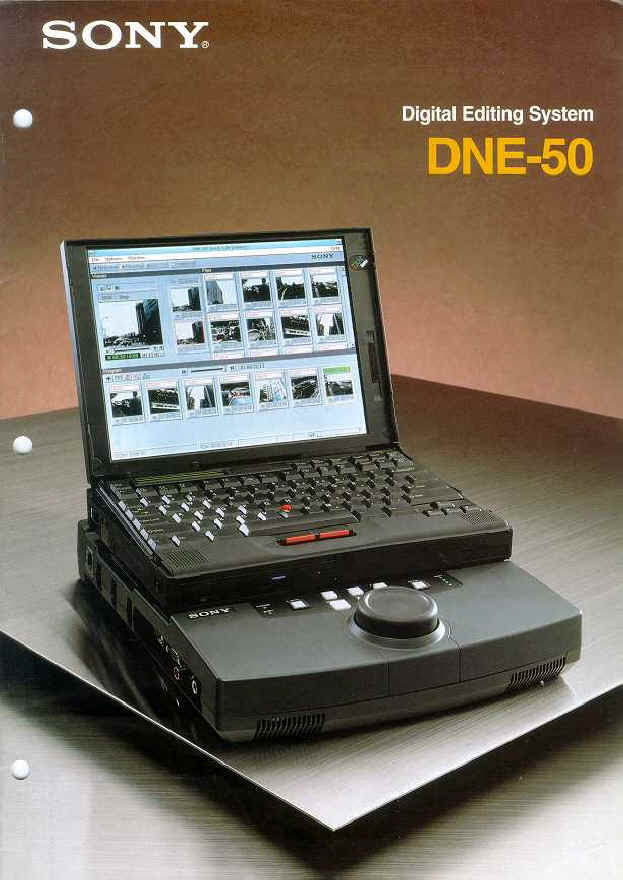
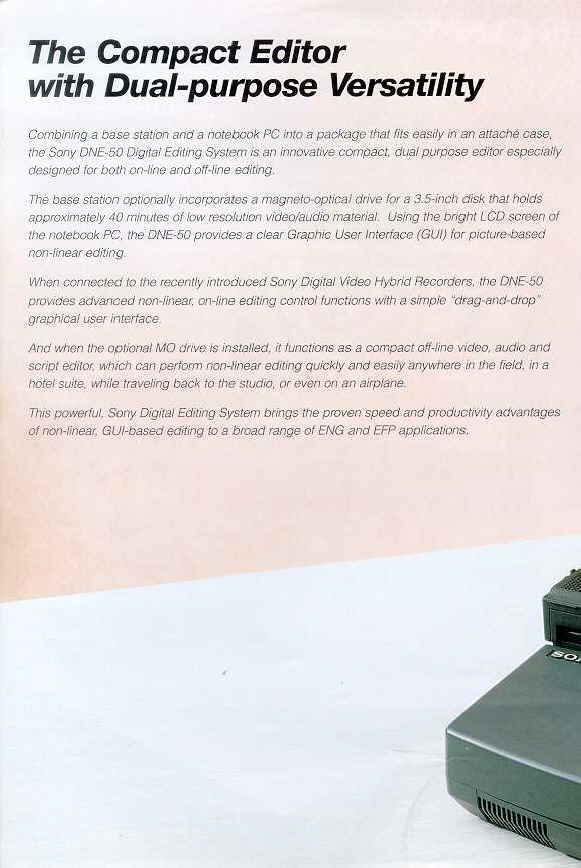 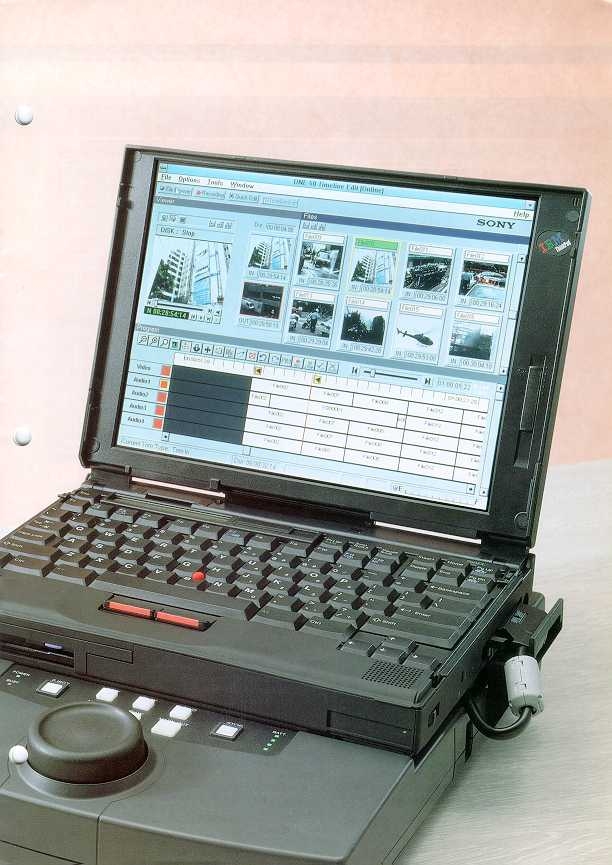
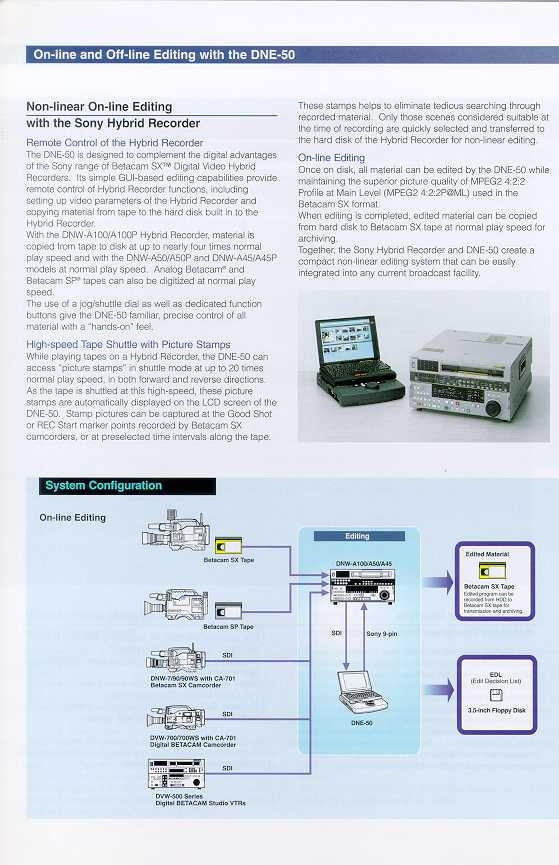 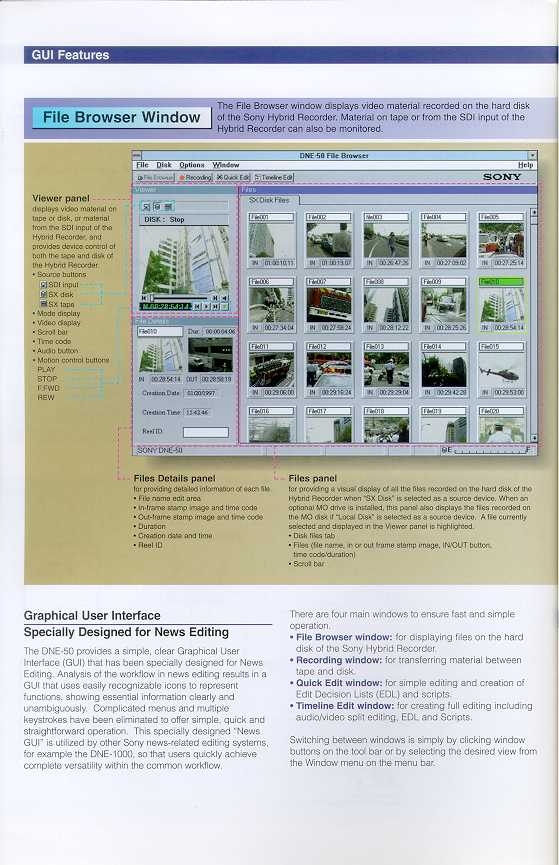
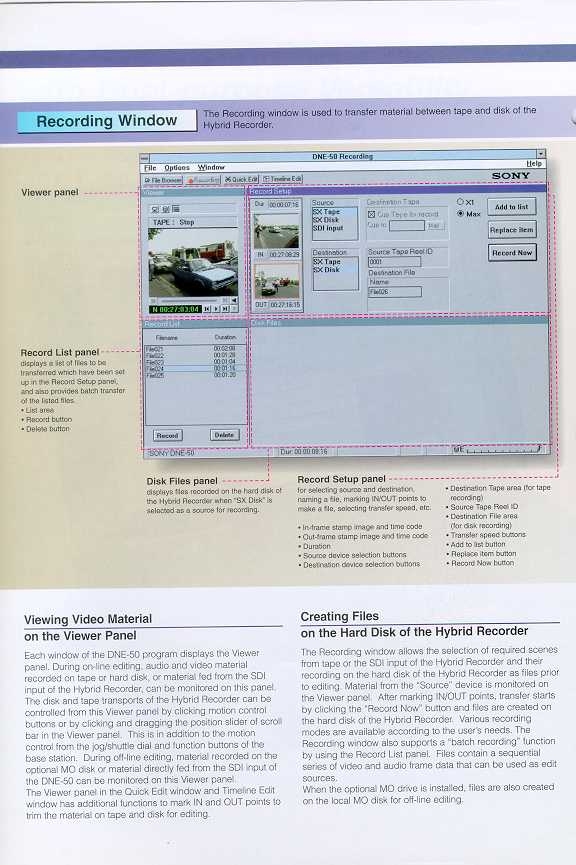 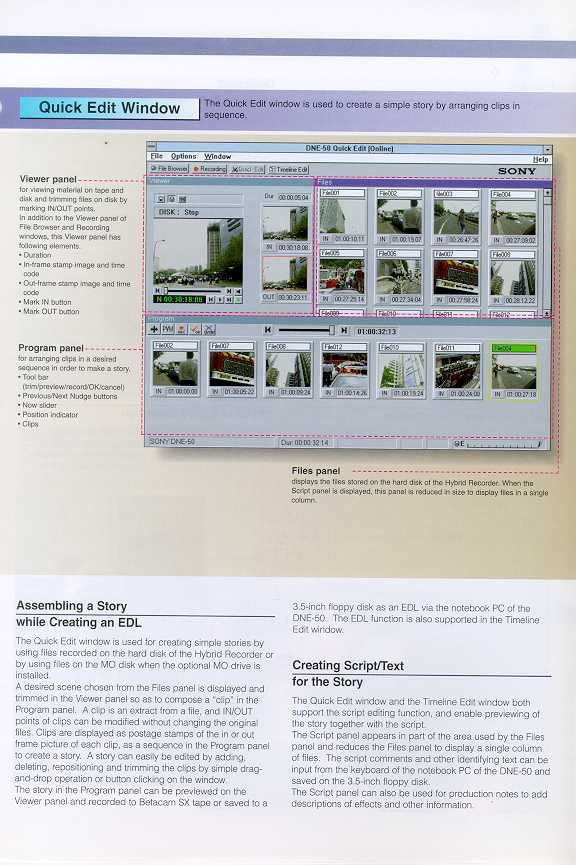
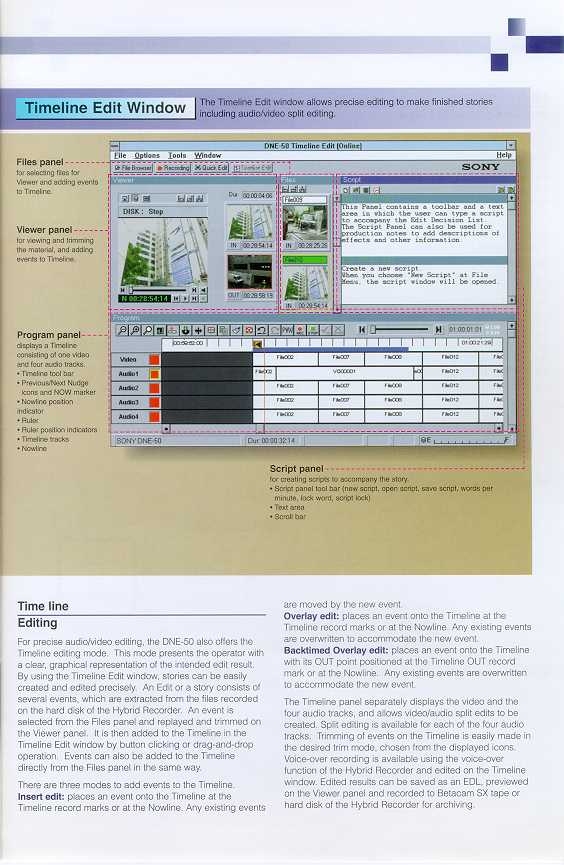 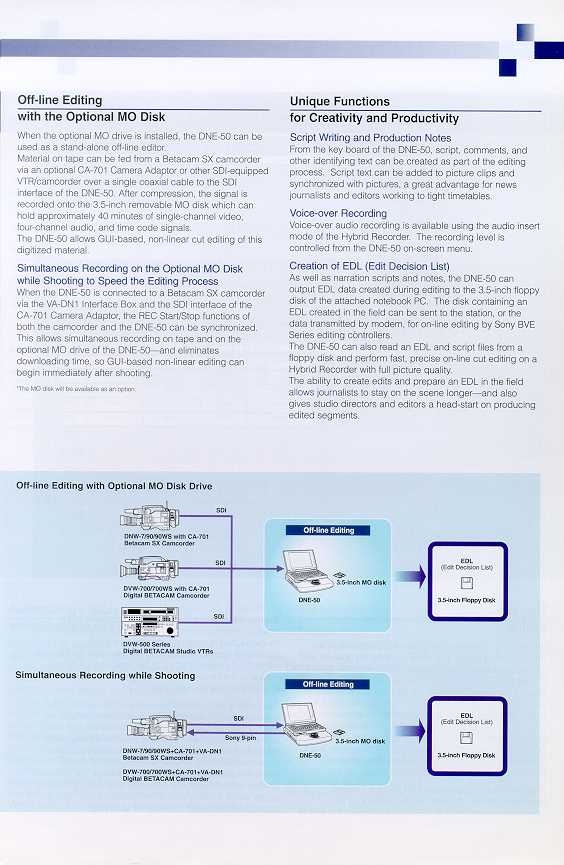
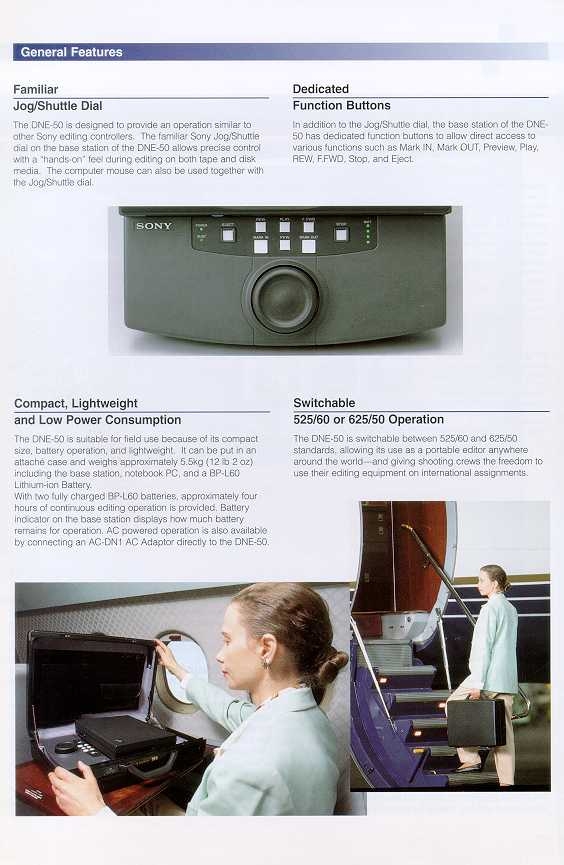 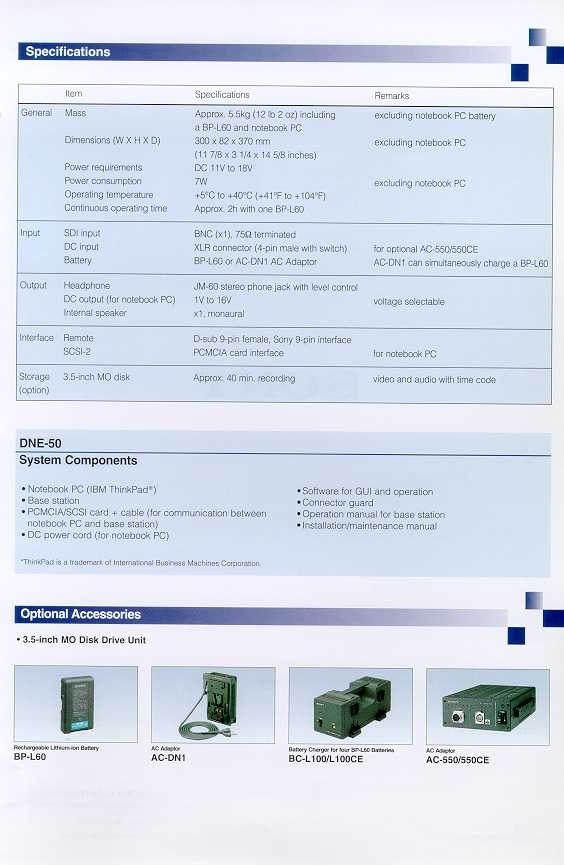
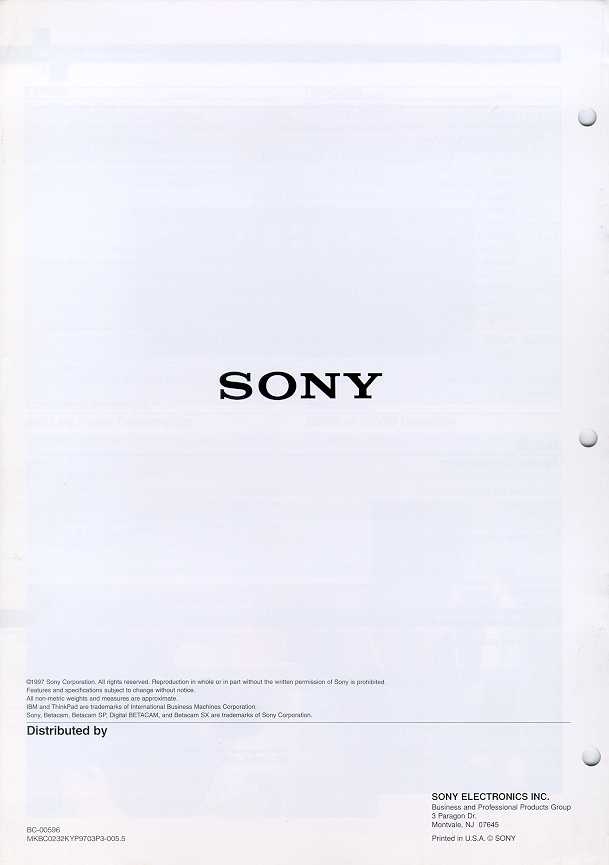
|
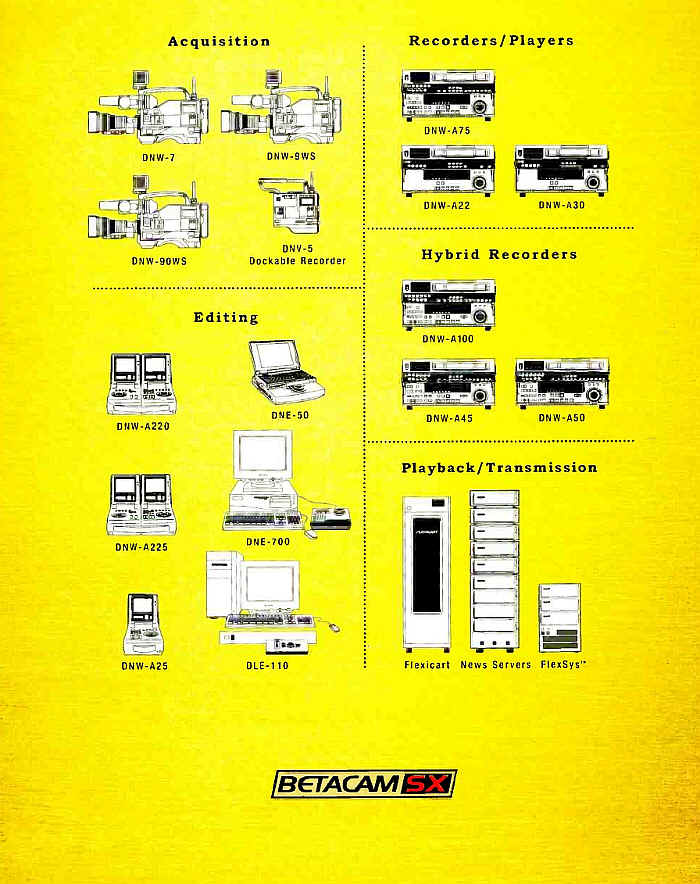 |
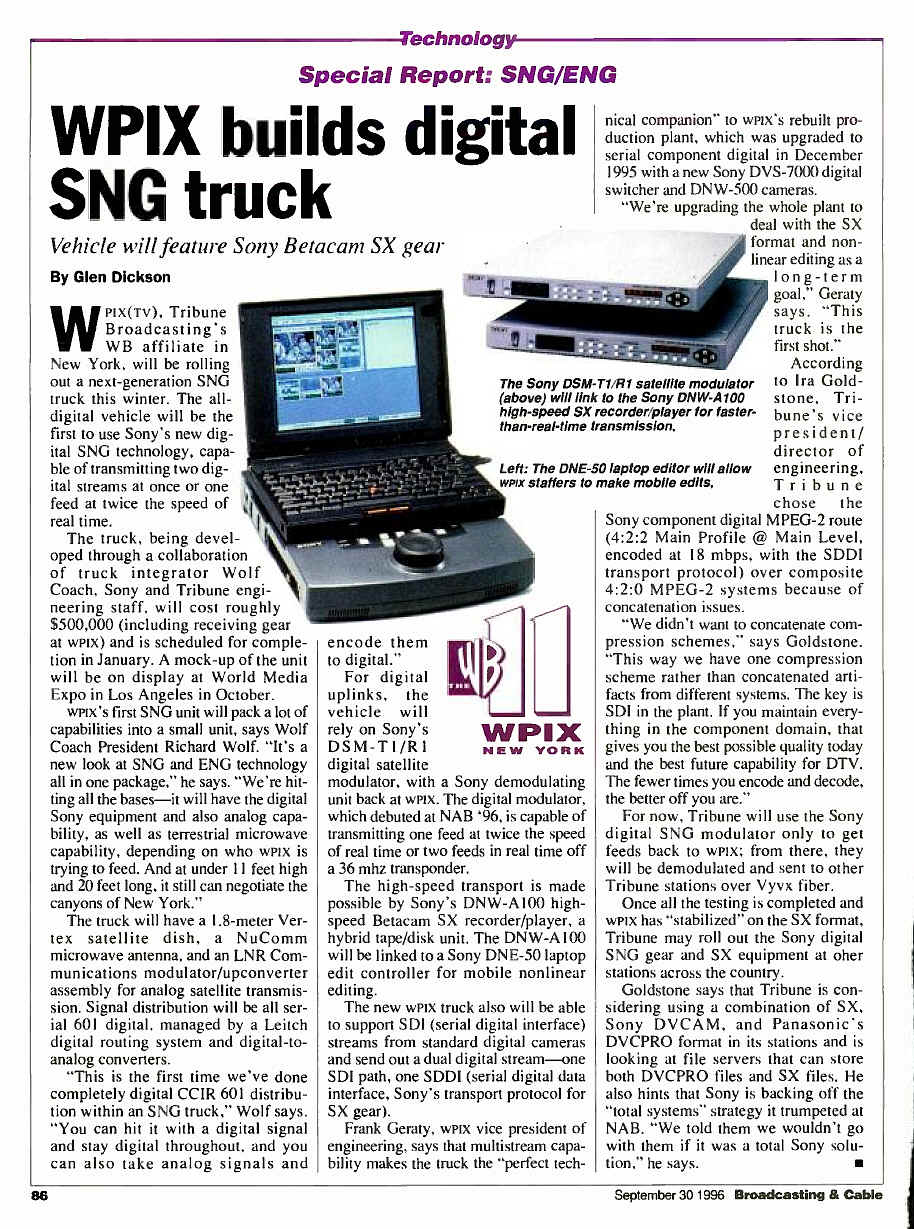
|
Special Report:
SNG /ENG
WPIX builds digital
ENG truck
Vehicle will
feature Sony Betacam
SX gear
By Glen Dickson
By Glen Dickson
WPIX(Tv), Tribune
Broadcasting's
WB affiliate in
New York, will be rolling
out a next -generation SNG
truck this winter. The all -
digital vehicle will be the
first to use Sony's new digital
SNG technology, capable
of transmitting two digital
streams at once or one
feed at twice the speed of
real time.
The truck, being developed
through a collaboration
of truck integrator Wolf
Coach, Sony and Tribune engineering
staff, will cost roughly
$500,000 (including receiving gear
at wplx) and is scheduled for completion
in January. A mock -up of the unit
will be on display at World Media
Expo in Los Angeles in October.
wPIX's first SNG unit will pack a lot of
capabilities into a small unit, says Wolf
Coach President Richard Wolf. "It's a
new look at SNG and ENG technology
all in one package," he says. "We're hitting
all the bases -it will have the digital
Sony equipment and also analog capability,
as well as terrestrial microwave
capability, depending on who WPIX is
trying to feed. And at under 11 feet high
and 20 feet long, it still can negotiate the
canyons of New York."
The truck will have a 1.8 -meter Vertex
satellite dish, a NuComm
microwave antenna, and an LNR Communications
modulator /upconverter
assembly for analog satellite transmission.
Signal distribution will be all serial
601 digital, managed by a Leitch
digital routing system and digital -toanalog
converters.
"This is the first time we've done
completely digital CCIR 601 distribution
within an SNG truck," Wolf says.
"You can hit it with a digital signal
and stay digital throughout, and you
can also take analog signals and
|
encode them
to digital."
For digital
uplinks, the
vehicle will
rely on Sony's
DSM -Tl /Rl
digital satellite
modulator, with a Sony demodulating
unit back at wPlx. The digital modulator,
which debuted at NAB '96, is capable of
transmitting one feed at twice the speed
of real time or two feeds in real time off
a 36 mhz transponder.
The high -speed transport is made
possible by Sony's DNW -A100 highspeed
Betacam SX recorder /player, a
hybrid tape /disk unit. The DNW -A100
will be linked to a Sony DNE -50 laptop
edit controller for mobile nonlinear
editing.
The new WPIX truck also will be able
to support SDI (serial digital interface)
streams from standard digital cameras
and send out a dual digital stream -one
SDI path, one SDDI (serial digital data
interface, Sony's transport protocol for
SX gear).
Frank Geraty, WPIX vice president of
engineering, says that multistream capability
makes the truck the "perfect tech-
|
nical companion" to wPlx's rebuilt production
plant, which was upgraded to
serial component digital in December
1995 with a new Sony DVS -7000 digital
switcher and DNW -500 cameras.
"We're upgrading the whole plant to
deal with the SX
format and nonlinear
editing as a
long -term
goal," Geraty
says. "This
truck is the
first shot."
According
to Ira Goldstone,
Tribune's
vice
president/
director of
engineering, Tribune
chose the
Sony component digital MPEG -2 route
(4:2:2 Main Profile @ Main Level,
encoded at 18 mbps, with the SDDI
transport protocol) over composite
4:2:0 MPEG -2 systems because of
concatenation issues.
"We didn't want to concatenate compression
schemes," says Goldstone.
"This way we have one compression
scheme rather than concatenated artifacts
from different systems. The key is
SDI in the plant. If you maintain everything
in the component domain, that
gives you the best possible quality today
and the best future capability for DTV.
The fewer times you encode and decode,
the better off you are."
For now, Tribune will use the Sony
digital SNG modulator only to get
feeds back to wPIx; from there, they
will be demodulated and sent to other
Tribune stations over Vyvx fiber.
Once all the testing is completed and
WPIX has "stabilized" on the SX format,
Tribune may roll out the Sony digital
SNG gear and SX equipment at oher
stations across the country.
Goldstone says that Tribune is considering
using a combination of SX,
Sony DVCAM, and Panasonic's
DVCPRO format in its stations and is
looking at file servers that can store
both DVCPRO files and SX files. He
also hints that Sony is backing off the
"total systems" strategy it trumpeted at
NAB. "We told them we wouldn't go
with them if it was a total Sony solution,"
he says.
|
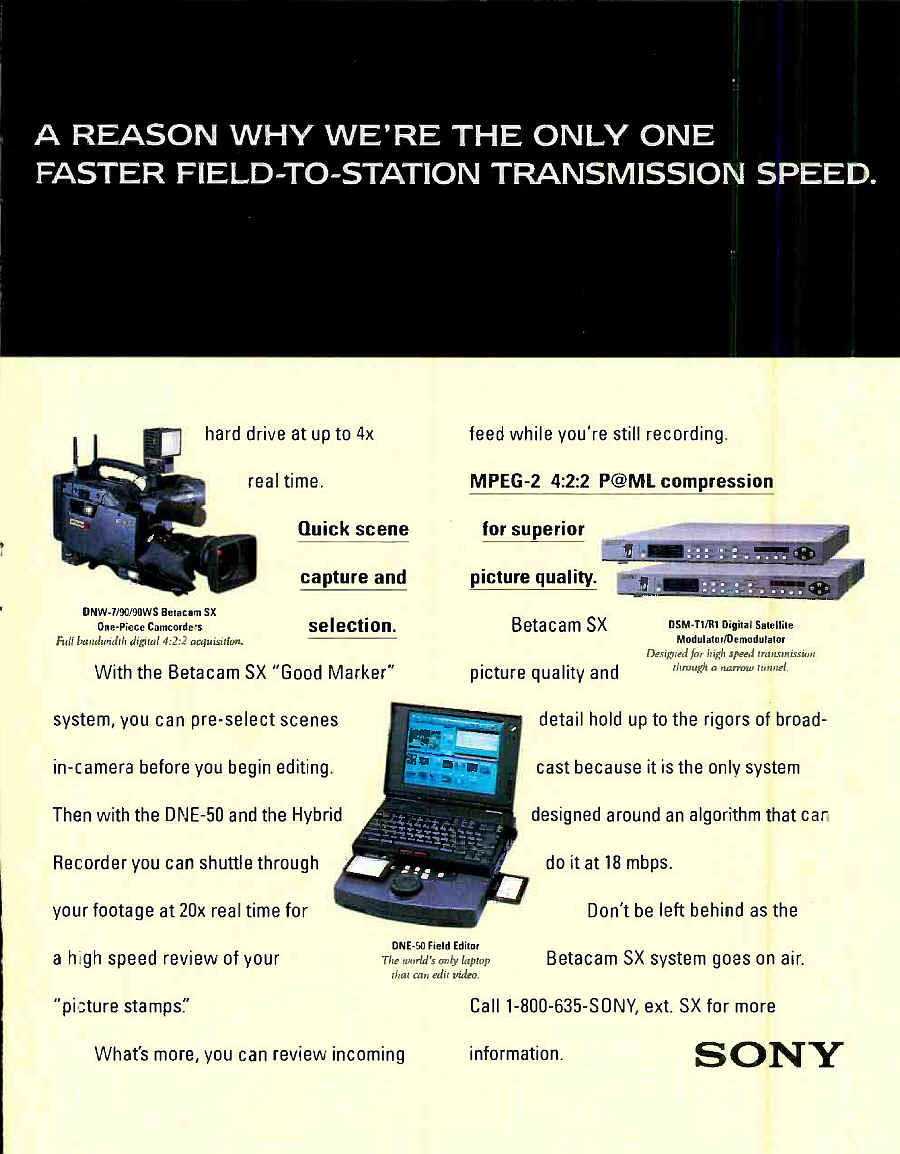
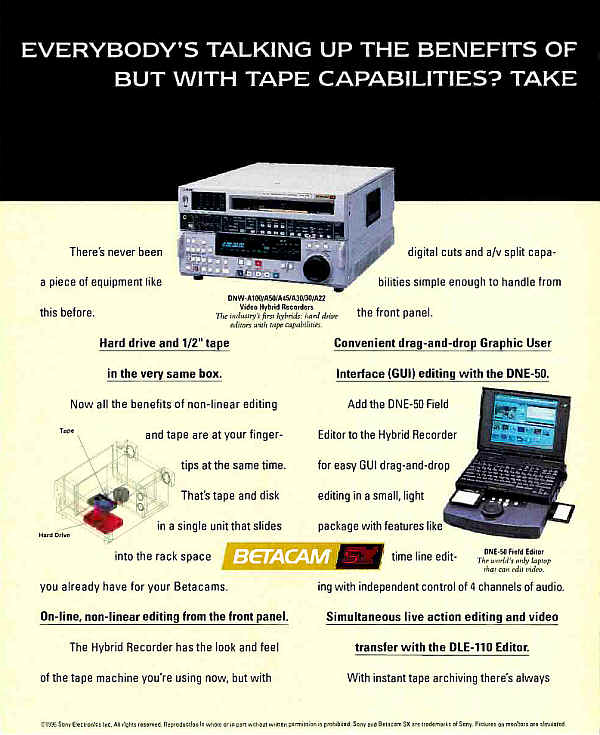
|
|
Sony unveils
components of
digital facility
Will bring
'shippable' hardware and software to
NAB
By Glen Dickson
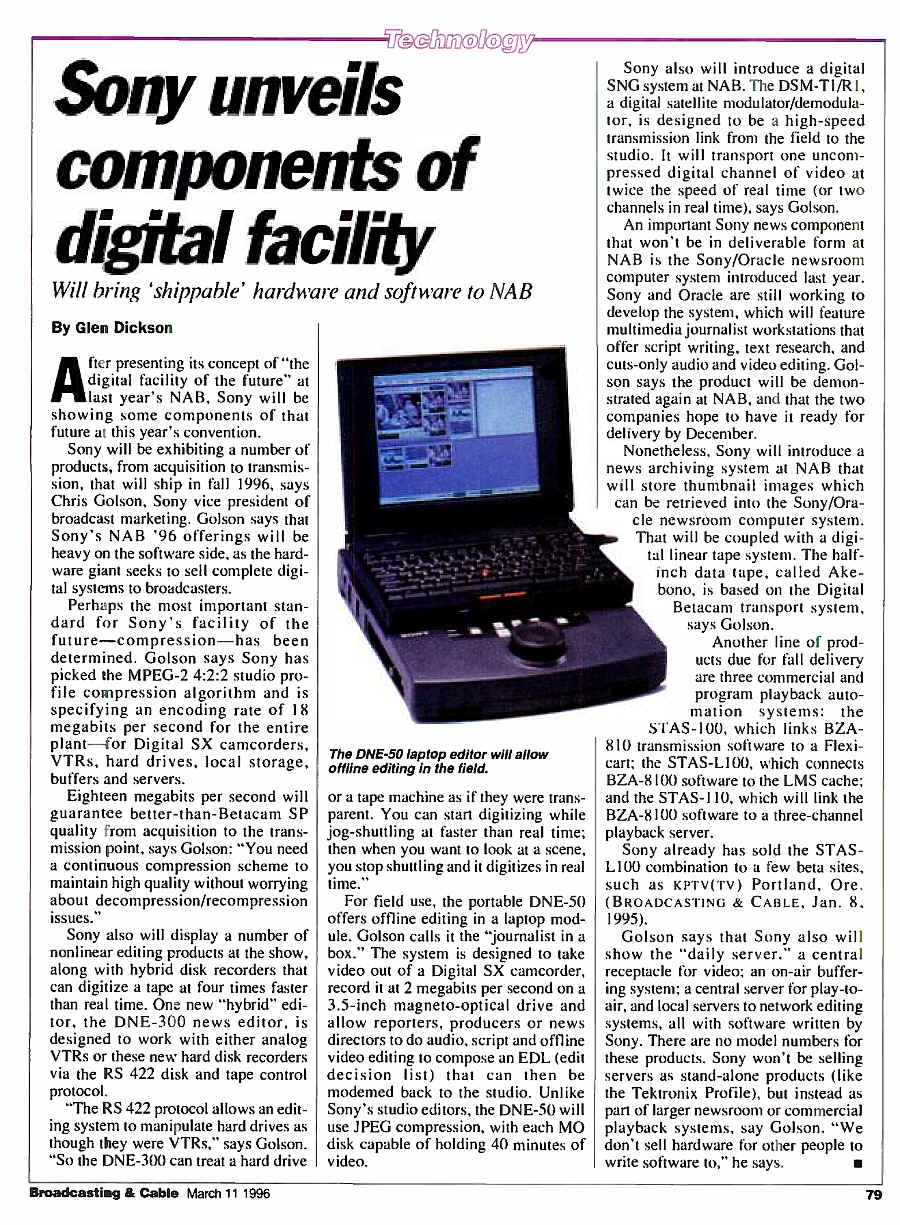
By Glen Dickson
Alter presenting its concept of "the
digital facility of the future" at
last year's NAB, Sony will be
showing some components of that
future at this year's convention.
Sony will be exhibiting a number of
products, from acquisition to transmission,
that will ship in fall 1996, says
Chris Golson, Sony vice president of
broadcast marketing. Golson says that
Sony's NAB '96 offerings will be
heavy on the software side, as the hardware
giant seeks to sell complete digital
systems to broadcasters.
Perhaps the most important standard
for Sony's facility of the
future -compression -has been
determined. Golson says Sony has
picked the MPEG -2 4:2:2 studio profile
compression algorithm and is
specifying an encoding rate of 18
megabits per second for the entire
plant -for Digital SX camcorders.
VTRs, hard drives, local storage.
buffers and servers.
Eighteen megabits per second will
guarantee better -than - Betacam SP
quality from acquisition to the transmission
point, says Golson: "You need
a continuous compression scheme to
maintain high quality without worrying
about decompression /recompression
issues."
Sony also will display a number of
nonlinear editing products at the show,
along with hybrid disk recorders that
can digitize a tape at four times faster
than real time. One new "hybrid" editor,
the DNE -300 news editor, is
designed to work with either analog
VTRs or these new hard disk recorders
via the RS 422 disk and tape control
protocol.
"The RS 422 protocol allows an editing
system to manipulate hard drives as
though they were VTRs," says Golson.
"So the DNE -300 can treat a hard drive
or a tape machine as if they were transparent.
You can start digitizing while
jog- shuttling at faster than real time;
then when you want to look at a scene,
you stop shuttling and it digitizes in real
time."
For field use, the portable DNE -50
offers offline editing in a laptop module.
Golson calls it the "journalist in a
box." The system is designed to take
video out of a Digital SX camcorder,
record it at 2 megabits per second on a
3.5 -inch magneto- optical drive and
allow reporters, producers or news
directors to do audio, script and offline
video editing to compose an EDL (edit
decision list) that can then be
modemed back to the studio. Unlike
Sony's studio editors, the DNE -50 will
use JPEG compression, with each MO
disk capable of holding 40 minutes of
video.
Sony also will introduce a digital
SNG system at NAB. The DSM -T1/R 1,
a digital satellite modulator /demodulator,
is designed to be a high -speed
transmission link from the field to the
studio. It will transport one uncompressed
digital channel of video at
twice the speed of real time (or two
channels in real time), says Golson.
An important Sony news component
that won't be in deliverable form at
NAB is the Sony /Oracle newsroom
computer system introduced last year.
Sony and Oracle are still working to
develop the system, which will feature
multimedia journalist workstations that
offer script writing, text research, and
cuts -only audio and video editing. Golson
says the product will be demonstrated
again at NAB, and that the two
companies hope to have it ready for
delivery by December.
Nonetheless, Sony will introduce a
news archiving system at NAB that
will store thumbnail images which
can be retrieved into the Sony /Oracle
newsroom computer system.
Broadcasting & Cable March 11 1996
That will be coupled with a digital
linear tape system. The half -
inch data tape, called Ake -
bono, is based on the Digital
Betacam transport system,
says Colson.
Another line of products
due for fall delivery
are three commercial and
program playback automation
systems: the
STAS -100, which links BZA -
810 transmission software to a Flexicart;
the STAS -L100, which connects
BZA -8100 software to the LMS cache;
and the STAS -110, which will link the
BZA -8100 software to a three -channel
playback server.
Sony already has sold the STASL100
combination to a few beta sites,
such as KPTV(TV) Portland, Ore.
(BROADCASTING & CABLE, Jan. 8,
1995).
Golson says that Sony also will
show the "daily server," a central
receptacle for video; an on -air buffering
system; a central server for play -toair,
and local servers to network editing
systems, all with software written by
Sony. There are no model numbers for
these products. Sony won't be selling
servers as stand -alone products (like
the Tektronix Profile), but instead as
part of larger newsroom or commercial
playback systems, say Golson. "We
don't sell hardware for other people to
write software to," he says.
|
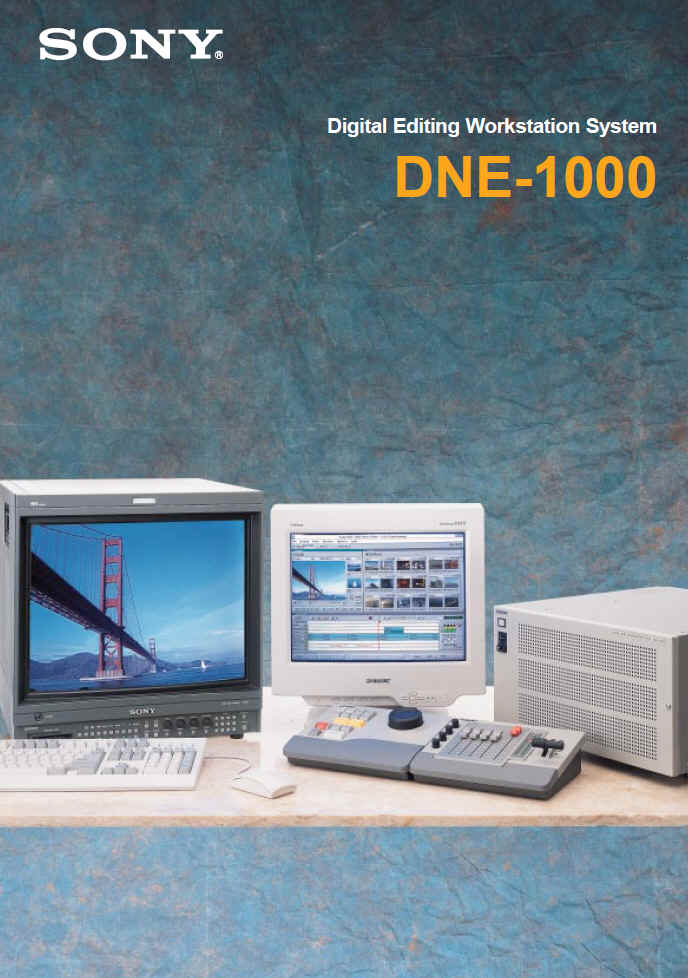
|


















